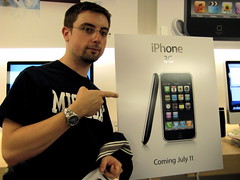Predicting the iPhone 5 years before it happens…thanks to Newton rumors
July 29th, 2008He may not even remember, but in August 2002, Leander Kahney of Cult of Mac posted a piece called “Newton’s Return: A hit and a myth” on Newton resurgence rumors after a New York Times piece hinted at something called…
The iPhone.
The Times claimed “…Steve Jobs was pushing development of a new PDA-cum-cell-phone. Dubbed the iPhone, the device would lead Apple back into the dangerous ‘land of handhelds,’ the Times opined,” Kahney writes.
Flash forward a little under five years later, and everything comes to fruition. Amazing.
A pair of researchers studying the Cult of Newton found that such “brand communities” predicted or spread rumors that the MessagePad would return five times between its death in 1998 to 2002. “Through detailed analysis of news groups and websites,” Kahney writes, “the researchers conclude that the rebirth rumor is central to the ethos of the Newton community.”
Jesus Phone, anyone?
Any return of the Newton would simply validate “the platform’s technical superiority. If it’s good enough to be reintroduced, it’s good enough to keep using, fans reason.” Amen, brother. And the Newton idea did stick around: calendars, notes, third-party apps, unique input mechanism, e-mail on a handheld – they’re all there on the iPhone today.
I couldn’t believe I saw the word “iPhone” pop up in an article from 2002. We all know that Apple started working on the iPhone years ago. But sometimes those crazy rumors have a way of surfacing – and resurfacing – time and time again.













